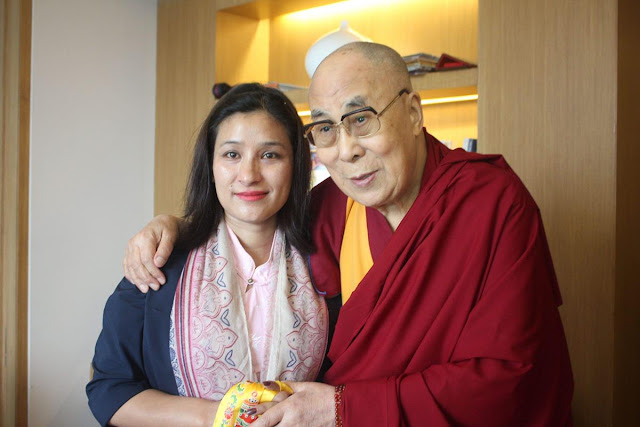Mount
Everest, located on the top of the world, rising 29,035 feet (8850 meters)
above sea level, attracts people. Known
in Nepal as Sagarmāthā and in China as Chomolungma, Everest is Earth's highest mountain. Its peak is 8,848
metres (29,029 ft) ~ although more than
4,000 people have scaled the summit since Sir Edmund Hilary and Sherpa Tenzing
Norgay first conquered the mountain in 1953, hundreds have also perished. Statistics reveal that scaling Everest is
much easier than it used to be. In 1990 just 18 per cent of summit attempts
were successful, but in 2012 that figure was 56 per cent.
Arunachal
Pradesh mountaineer Anshu Jamsenpa recently scripted history by becoming the
first Indian woman to scale Mount Everest for the fourth time. Jamsenpa, a mother of two, started her
expedition on May 13 and reached the highest peak of the world on Tuesday
morning to unfurl the national flag. Besides
Jamsenpa, 17 other climbers also made it to the top of Mt Everest on Tuesday
morning.
Anshu seen with Dalai Lama [credit Indian Express]
More statistics
reveal that the 2016 spring climbing season on Everest, from both sides, was
about as normal as it gets these days. 640 people summited – half being Sherpa
support. Five people died – lower than the average of eight deaths each season
since 2000. .. .. I am surprised to read
that there is some high cost involved in climbing Everest and not all commoners
can do that.
In any event, I
hope the good outweighed the profit but it is time for this type of activity to
end, imho. The permit cost is fixed at
$11,000 per climber from Nepal. In Nepal, the permit fee simply gives
permission to climb. Nepal requires
using a local company to organize your permit at a cost of $2,500 for the team,
a refundable trash deposit of $4,000 for the team plus a Liaison Officer
costing $3,000 per team. Nepal implemented in 2013 a new rule that requires
every foreign climber in Nepal to hire a local Sherpa Guide. Most guide companies on the Nepal side will
require at least evacuation insurance and most require medical coverage. One of
the best investments you can make is to add trip cancellation to the policy. In
both 2014 and 2015 when the Everest season ended early, those with trip
cancellation/interruption coverage had 100% of their trip expenses reimbursed.
As there
is fees, there is evasion too ~ that is man(un)kind. MailOnline today reports of a man caught climbing Mount Everest without
paying the £8,500 fee being placed in
custody following an argument with tourism officials after he climbed down.
It is reported that Nepalese officials
discovered South African Ryan Sean Davy in his hideaway after he had climbed
more than 20,000 feet up the world's highest mountain. He was ordered off the
mountain, had his passport confiscated and now faces s £17,000 ($22,000) fine.
Davy handed himself in to authorities in Kathmandu on Tuesday after being
caught last week.
The 43-year-old
began swearing and threatening officials from the tourism department during
questioning and was arrested under Nepal's strict public order laws, Tourist
Police Inspector Tulasha Khatiwada told AFP.
He is now in custody and will appear in court next week to face charges
related to his Everest attempt and possible additional offences over his
conduct during the investigation. 'He will be fined and deported as per the
Tourism Act of Nepal. He may face further penalty for misbehaving with the
police,' director of the tourism department Dinesh Bhattarai told AFP.
Foreigners have to
pay the Nepal government $11,000 for permission to climb the 29,029ft peak - a
major earner for the impoverished country. Under Nepali law, climbers caught
without the mandatory permit are fined $22,000.
When there is such a specific law, the first thing that it reveals that
there have been some occasions of persons violating and trying to climb without
paying the fee !!
Ryan Sean Davy could also be blacklisted from the Himalayan
nation for five years, or face a 10-year climbing ban when he appears in court
next week. The South African - who describes himself on social media as a film
director and producer - was caught a short distance from Everest base camp and
was ordered off the mountain. He had pitched a tent away from the other
climbers to try and dodge government officials who monitor all Everest ascents.
He told officials he had climbed alone as far as camp two - at 6,400 metres -
to acclimatise in preparation for a solo summit bid. His antics have angered
many in the close-knit climbing community, who say the South African would have
put himself and others in danger if he had attempted to reach the summit alone.
In a Facebook post, the man who was caught cheating, claimed to have been 'treated like a
murderer' after being discovered and thought he was 'going to get stoned to
death right there.'
Nepal, home to
eight of the world's 14 highest mountains, has more than 2,000 Himalayan peaks
and 326 are open to foreign climbers. Mountaineering is an important component
of tourism that makes up about 4 per cent of the impoverished nation's GDP. Along with the pricey climbing permit,
Nepal's Department of Tourism requires Everest climbers to be at least 16 but
there's no upper age limit. It is highly
unusual for a foreign climber to attempt to scale Everest alone - most do so
with the help of at least one sherpa guide and a large support team at base
camp. It is further reported that there are 373 foreign climbers currently on peak who
will attempt to summit in the coming weeks with the help of at least one Sherpa
guide each.
With regards – S.
Sampathkumar
17th May
2017.
Pic credit
:alpineascent.com.


No comments:
Post a Comment